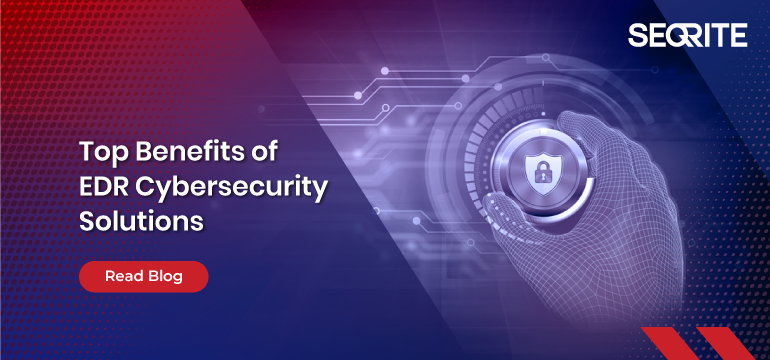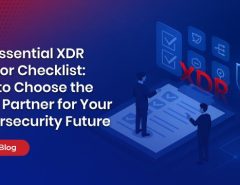In today’s hyper-connected world, cyberattacks are no longer just a technical issue, they are a serious business risk. From ransomware shutting down operations to data breaches costing millions, the threat landscape is constantly evolving. According to IBM’s 2024 Cost of a Data Breach Report, the global average cost of a data breach has reached 4.45 million dollars, marking a 15 percent increase over the past three years. As a result, more organizations are turning to EDR cybersecurity solutions.
EDR offers real-time monitoring, threat detection, and rapid incident response to protect endpoints like desktops, and laptops from malicious activity. These capabilities are critical for minimizing the impact of attacks and maintaining operational resilience. Below are the top benefits of implementing EDR cybersecurity in your organization.
Top EDR Cybersecurity Benefits
1. Improved Visibility and Threat Awareness
In a modern enterprise, visibility across all endpoints is crucial. EDR offers a comprehensive lens into every device, user activity, and system process within your network.
-
Continuous Endpoint Monitoring
EDR agents installed on endpoints continuously collect data related to file access, process execution, login attempts, and more. This enables 24/7 monitoring of activity across desktops, and mobile devices regardless of location.
-
Behavioral Analytics
EDR solutions use machine learning to understand normal behavior across systems and users. When anomalies occur—like unusual login patterns or unexpected file transfers—they are flagged for investigation.
-
Detailed Forensics
Historical data and activity logs help security teams reconstruct the sequence of events during an incident. This supports root cause analysis and helps prevent similar attacks in the future.
2. Faster Threat Response and Containment
In cybersecurity, response speed is critical. Delayed action can lead to data loss, system compromise, and reputational damage.
-
Real-Time Containment
EDR solutions enable security teams to isolate infected endpoints instantly, preventing malware from spreading laterally through the network. Even if the endpoint is rebooted or disconnected, containment policies remain active.
-
Automated Response Workflows
EDR systems support predefined rules for automatic responses such as:
- Killing malicious processes
- Quarantining suspicious files
- Blocking communication with known malicious IPs
- Disconnecting compromised endpoints from the network
-
Protection for Offline Devices
Remote endpoints or those operating without an internet connection remain protected. Security policies continue to function, ensuring consistent enforcement even in disconnected environments.
According to IDC’s 2024 report on endpoint security, companies with automated EDR solutions reduced their average incident containment time by 60 percent.
3. Regulatory Compliance and Reporting
Compliance is no longer optional—especially for organizations in healthcare, finance, government, and other regulated sectors. EDR tools help meet these requirements.
-
Support for Compliance Standards
EDR solutions help organizations meet GDPR, HIPAA, PCI-DSS, and the Indian DPDP Act by:
- Enforcing data encryption
- Applying strict access controls
- Maintaining audit logs of all system and user activities
- Enabling rapid response and documentation of security incidents
-
Simplified Audit Readiness
Automated report generation and log retention ensure that organizations can quickly present compliance evidence during audits.
-
Proactive Compliance Monitoring
EDR platforms identify areas of non-compliance and provide recommendations to fix them before regulatory issues arise.
HIPAA, for instance, requires logs to be retained for at least six years. EDR solutions ensure this requirement is met with minimal manual intervention.
4. Cost Efficiency and Operational Gains
Strong cybersecurity is not just about prevention it is also about operational and financial efficiency. EDR helps reduce the total cost of ownership of security infrastructure.
-
Lower Incident Management Costs
According to Deloitte India’s Cybersecurity Report 2024, companies using EDR reported an average financial loss of 42 million rupees per attack. In contrast, companies without EDR reported average losses of 253 million rupees.
-
Reduced Business Disruption
EDR solutions enable security teams to isolate only affected endpoints rather than taking entire systems offline. This minimizes downtime and maintains business continuity.
-
More Efficient Security Teams
Security analysts often spend hours manually investigating each alert. EDR platforms automate much of this work by providing instant analysis, root cause identification, and guided response steps. This frees up time for more strategic tasks like threat hunting and policy improvement.
The Ponemon Institute’s 2024 report notes that organizations using EDR reduced average investigation time per incident by 30 percent.
5. Protection Against Advanced and Evolving Threats
Cyberthreats are evolving rapidly, and many now bypass traditional defenses. EDR solutions are built to detect and respond to these sophisticated attacks.
-
Detection of Unknown Threats
Unlike traditional antivirus software, EDR uses heuristic and behavioral analysis to identify zero-day attacks and malware that do not yet have known signatures.
-
Defense Against Advanced Persistent Threats (APTs)
EDR systems correlate seemingly minor events such as login anomalies, privilege escalations, and file modifications—into a single threat narrative that identifies stealthy attacks.
-
Integration with Threat Intelligence
EDR platforms often incorporate global and local threat feeds, helping organizations respond to emerging threats faster and more effectively.
Verizon’s 2024 Data Breach Investigations Report found that 70 percent of successful breaches involved endpoints, highlighting the need for more advanced protection mechanisms like EDR.
Why Choose Seqrite EDR
Seqrite EDR cybersecurity is designed to meet the needs of today’s complex and fast-paced enterprise environments. It provides centralized control, powerful analytics, and advanced response automation all in a user-friendly package.
Highlights of Seqrite EDR Cybersecurity:
- Powered by GoDeep.AI for deep behavioral analysis
- Unified dashboard for complete endpoint visibility
- Seamless integration with existing IT infrastructure
- Resilient protection for remote and offline devices
- Scalability for growing enterprise needs
Seqrite EDR is especially well-suited for industries such as finance, healthcare, manufacturing, and government, where both threat risk and compliance pressure are high.
Conclusion
EDR cybersecurity solutions have become a strategic necessity for organizations of all sizes. They offer comprehensive protection by detecting, analyzing, and responding to threats across all endpoints in real time. More importantly, they help reduce incident costs, improve compliance, and empower security teams with automation and insight.
Seqrite Endpoint Detection and Response provides a powerful, cost-effective way to future-proof your organization’s cybersecurity. By adopting Seqrite EDR, you can strengthen your cyber defenses, reduce operational risk, and ensure compliance with evolving regulations.
To learn more, visit www.seqrite.com and explore how Seqrite EDR can support your business in the age of intelligent cyber threats.




